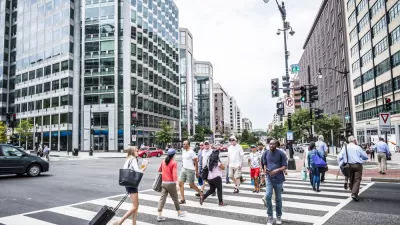Nate Berg offers his take on the replicas of Western subdivisions that have come to define social status in the burgeoning economies of the Middle and Far East.
It's often said that America's most important export is its culture, and in recent years, that's meant more than rock and roll and fast cars. Throughout the booming economies of the east (China is the prime culprit), planned communities are being manufactured wholesale, modeled after American suburbs and European towns.
Responding to demand for the trappings of a Western lifestyle (and the social status that comes with it), communities like Beverly Hills and Orange County are materializing halfway around the world from their namesakes.
These "imposturbs," which Berg calls "a little absurd," don't always meet with overwhelming success. Shanghai's "One City, Nine Towns" community, which features separate districts themed after "England, Spain, Sweden, the U.S., the Netherlands, Australia, Canada, Germany and Italy... haven't actually become 'towns,' as few people have moved in." Instead the development has become a destination for wedding photo backdrops and television commercials.
As Berg explains, "This style of imitation building is not new. In fact there's an early example right here in the U.S., the 1920s-era development of Coral Gables, Florida, where developer George Merrick and the American Building Corporation built six themed villages" modeled on European and Chinese architecture. Berg, however, takes a less sardonic view of the Coral Gables developments, since they "were designed meticulously by architects with firsthand experience in the places that inspired each village."
"To a certain degree, it's no different than all the various brand names that you might see for handbags or something," says author Thomas Campanella. "[Developers are] all trying to hit upon the Louis Vuitton of residential architecture. It's a brand consciousness. It's very consumer driven."
FULL STORY: The Curious Case of the 'Imposturbs'

Planetizen Federal Action Tracker
A weekly monitor of how Trump’s orders and actions are impacting planners and planning in America.

Maui's Vacation Rental Debate Turns Ugly
Verbal attacks, misinformation campaigns and fistfights plague a high-stakes debate to convert thousands of vacation rentals into long-term housing.

San Francisco Suspends Traffic Calming Amidst Record Deaths
Citing “a challenging fiscal landscape,” the city will cease the program on the heels of 42 traffic deaths, including 24 pedestrians.

Defunct Pittsburgh Power Plant to Become Residential Tower
A decommissioned steam heat plant will be redeveloped into almost 100 affordable housing units.

Trump Prompts Restructuring of Transportation Research Board in “Unprecedented Overreach”
The TRB has eliminated more than half of its committees including those focused on climate, equity, and cities.

Amtrak Rolls Out New Orleans to Alabama “Mardi Gras” Train
The new service will operate morning and evening departures between Mobile and New Orleans.
Urban Design for Planners 1: Software Tools
This six-course series explores essential urban design concepts using open source software and equips planners with the tools they need to participate fully in the urban design process.
Planning for Universal Design
Learn the tools for implementing Universal Design in planning regulations.
Heyer Gruel & Associates PA
JM Goldson LLC
Custer County Colorado
City of Camden Redevelopment Agency
City of Astoria
Transportation Research & Education Center (TREC) at Portland State University
Jefferson Parish Government
Camden Redevelopment Agency
City of Claremont





























